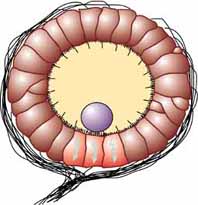Statocyst
Statocysts ( Greek στάτος Statos , standing 'and κύστις kystis , bubble') are equilibrium organs in invertebrate animals , which consist of a liquid-filled bubble, in which one or more statoliths are (a lime or grain of sand). When moving, the statolith comes into contact with the sensory hairs of the cover and irritates them. The stimulus is passed on to the nervous system and is used for spatial orientation.
Many invertebrates have statocysts, such as insects , jellyfish or crustaceans . In jellyfish they sit on the edges, while in crustaceans they are often at the foot of the antennae .
Experiments succeeded in exchanging the statoliths for metal chips and pulling them up using magnetic fields. Then the crabs swam upside down.
In the plant roots , more precisely in the root cap , statocytes are important for the gravitropism of the plants.
Individual evidence
- ^ A b c Neil A. Campbell: Biology . 8th edition. Pearson Benjamin Cummings, San Francisco 2008, ISBN 978-0-321-53616-7 , p. 1092.
